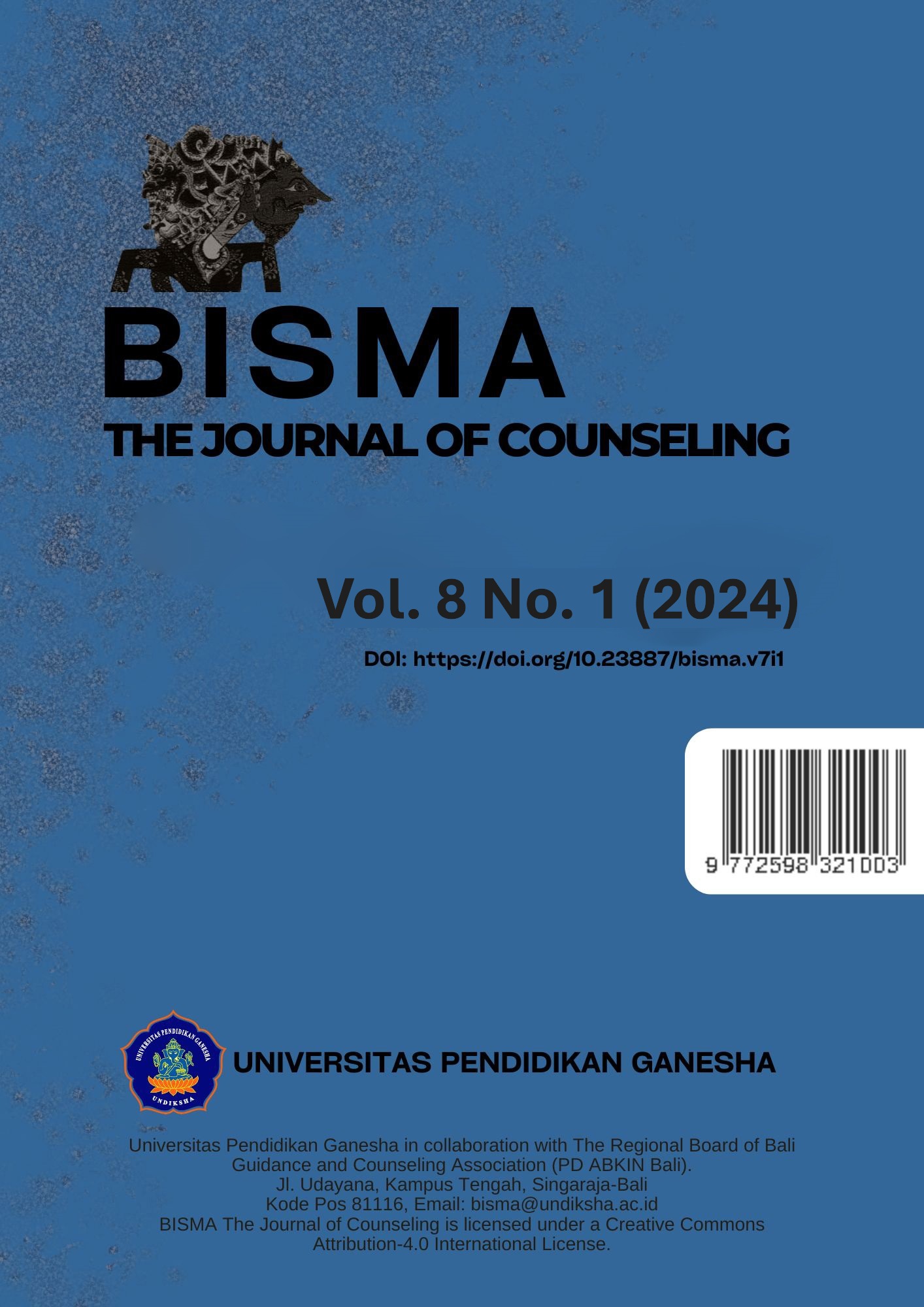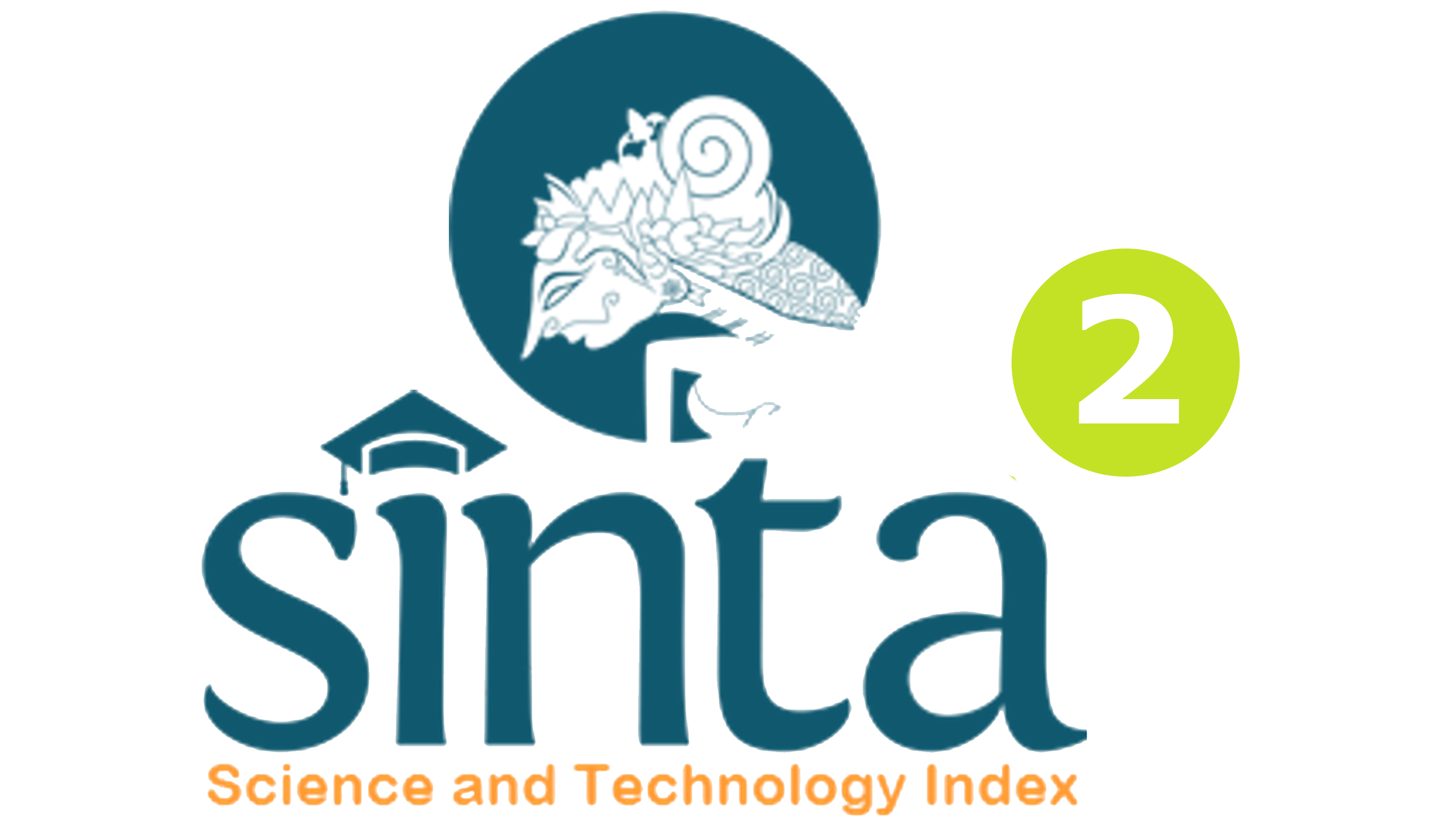Guidance and Counselling Services as Efforts to Enhance Awareness in Avoiding Cyber Dating Violence Among Young Adults
DOI:
https://doi.org/10.23887/bisma.v8i1.77775Keywords:
Cyber Dating Violence, Dating Violence, Intervention, Guidance and CounselingAbstract
Currently, cases of violence in dating in cyberspace are increasing along with advances in technology known as cyber dating violence (CDV). Cyber dating violence has an impact on psychological well-being and the ability to develop romantic relationships, thus disrupting the early developmental tasks of adults. Guidance and Counseling play a role in achieving optimal developmental tasks. Guidance and Counseling play a role in achieving optimal developmental tasks, so it is necessary to determine the right services for CDV cases. The purpose of this study was to analyze Guidance and Counseling services that can increase awareness to avoid CDV. This literature review uses a systematic literature review approach. The literature used is mainly sourced through the Harzing's Publish or Perish application, considering reputable articles from 2013 to 2023 from databases such as Scopus, SAGE Journals, Taylor and Francis, Wiley, and other eligible publishers. A total of 43 articles, 3 annual reports (CATAHU) from the National Commission on Violence Against Women, and 4 books were obtained. The findings from this literature review include methods, topics, and approaches related to CDV, which are then integrated into Guidance and Counseling services.
References
Aichner, T., Grünfelder, M., Maurer, O., & Jegeni, D. (2021). Twenty-Five Years of Social Media: A Review of Social Media Applications and Definitions from 1994 to 2019. Cyberpsychology, Behavior, and Social Networking, 24(4), 215–222. https://doi.org/10.1089/cyber.2020.0134.
Almira, N. S., & Marheni, A. (2021). Analisis Fenomenologis Interpretatif tentang Definisi Bullying dan Harga Diri bagi Korban Bullying. Jurnal Psikologi Integratif, 9(2), 209. https://doi.org/10.14421/jpsi.v9i2.2211.
Aradhana, A. A. A., & Pangaribuan, C. S. (2022). Cyberbullying in Media Social: A Mainstreaming the Victim Protection Principles in Indonesian Criminal Justice System. Indonesia Media Law Review, 1(2), 99–122. https://doi.org/10.15294/imrev.v1i2.60587.
Cava, M.-J., Tomás, I., Buelga, S., & Carrascosa, L. (2020). Loneliness, Depressive Mood and Cyberbullying Victimization in Adolescent Victims of Cyber Dating Violence. International Journal of Environmental Research and Public Health, 17(12), 4269. https://doi.org/10.3390/ijerph17124269.
Cava, M. J., Buelga, S., & Carrascosa, L. (2022). Cyber-control and cyber-aggression toward the partner in adolescent students: Prevalence and relationships with cyberbullying. Revista de Educacion, 2022(397), 169–195. https://doi.org/10.4438/1988-592X-RE-2022-397-544.
Choi, Y. J., Shin, S. Y., & Lee, J. (2022). Change in Factors Affecting Cyberbullying of Korean Elementary School Students during the COVID-19 Pandemic. International Journal of Environmental Research and Public Health, 19(17). https://doi.org/10.3390/ijerph191711046.
Cooper, A. C., & Sánchez, B. (2016). The roles of racial discrimination, cultural mistrust, and gender in Latina/o youth’s school attitudes and academic achievement. Journal of Research on Adolescence, 26(4), 1036–1047. https://doi.org/10.1111/jora.12263.
DeGue, S., Niolon, P. H., Estefan, L. F., Tracy, A. J., Le, V. D., Vivolo-Kantor, A. M., & Taylor, B. (2021). Effects of Dating Matters® on sexual violence and sexual harassment outcomes among middle school youth: A cluster-randomized controlled trial. Prevention Science, 22, 175–185. https://doi.org/10.1007/s11121-020-01152-0.
Dewi, L. P. Y. S., Suranata, K., & Gading, I. K. (2022). Pengembangan Panduan Konseling Cognitive Behavioral dengan Teknik Mindfulness untuk Mengatasi Trauma pada Anak-anak Korban Kekerasan Seksual. Jurnal EDUCATIO: Jurnal Pendidikan Indonesia, 8(2), 190. https://doi.org/10.29210/1202222629.
Dosil, M., Jaureguizar, J., Bernaras, E., & Sbicigo, J. B. (2020). Teen Dating Violence, Sexism, and Resilience: A Multivariate Analysis. International Journal of Environmental Research and Public Health, 17(8), 2652. https://doi.org/10.3390/ijerph17082652.
Garcia, P. J., Miranda, A. E., Gupta, S., Garland, S. M., Escobar, M. E., & Fortenberry, J. D. (2021). The role of sexually transmitted infections (STI) prevention and control programs in reducing gender, sexual and STI-related stigma. EClinicalMedicine, 33, 100764. https://doi.org/10.1016/j.eclinm.2021.100764.
Haenen, S., Nyklíček, I., Son, J. ., & Victor Pop, F. P. (2016). Mindfulness facets as differential mediators of short and long-term effects of Mindfulness-Based Cognitive Therapy in diabetes outpatients: Findings from the DiaMind randomized trial. Journal of Psychosomatic Research, 85(16), 44–50. https://doi.org/10.1016/j.jpsychores.2016.04.006.
Handley, H. K., Hillman, J., Finch, M., Ubide, T., Kachovich, S., McLaren, S., Petts, A., Purandare, J., Foote, A., & Tiddy, C. (2020). In Australasia, gender is still on the agenda in geosciences. Advances in Geosciences, 53, 205–226. https://doi.org/10.5194/adgeo-53-205-2020.
Hubert, C., Villalobos, A., Abreu, A. B., & Suárez-López, L. (2019). Sexual and reproductive health outcomes are positively associated with comprehensive sexual education exposure in Mexican high-school students. Salud Pública de México, 61(6, nov-dic), 1–12. https://doi.org/10.17605/OSF.IO/DEV2Y.
Karami, A., White, C. N., Ford, K., Swan, S., & Yildiz Spinel, M. (2020). Unwanted advances in higher education:Uncovering sexual harassment experiences in academia with text mining. Information Processing and Management, 57(2), 1–28. https://doi.org/10.1016/j.ipm.2019.102167.
Kristiyono, J. (2015). Budaya Internet: Perkembangan Teknologi Informasi Dan Komunikasi Dalam Mendukung Penggunaan Media Di Masyarakat. Scriptura, 5(1), 23–30. https://doi.org/10.9744/scriptura.5.1.23-30.
Lampropoulos, G., Siakas, K., & Anastasiadis, T. (2019). Internet of Things in the Context of Industry 4.0: An Overview. International Journal of Entrepreneurial Knowledge, 7(1), 4–19. https://doi.org/10.2478/ijek-2019-0001.
Laurensius, S., Situngkir, D., Putri, R., & Fauzi, R. (2019). Cyber Bullying Against Children In Indonesia. In Proceedings of the First International Conference on Social Sciences, Humanities, Economics and Law, 5–6. https://doi.org/10.4108/eai.5-9-2018.2281372.
Maulia, D., Rakhmawati, D., & Dewanto, F. M. (2022). Kontribusi guru pada pendidikan seksualitas anak usia dini. Intuisi: Jurnal Psikologi Ilmiah, 13(2), 234–246. https://doi.org/10.15294/intuisi.v13i2.31846.
Nurlia, A., & Suardiman, S. P. (2020). The phenomenon of bullying in junior high school students nowadays. International Journal of Education and Learning, 2(1), 7–13. https://doi.org/10.31763/ijele.v2i1.62.
Okoli, C. (2015). A guide to conducting a standalone systematic literature review. Communications of the Association for Information Systems, 37(43), 879–910. https://hal.science/hal-01574600/.
Parris, L., Lannin, D. G., Hynes, K., & Yazedjian, A. (2022). Exploring Social Media Rumination: Associations With Bullying, Cyberbullying, and Distress. Journal of Interpersonal Violence, 37(5–6), NP3041–NP3061. https://doi.org/10.1177/0886260520946826.
Pattiradjawane, C., Wijono, S., & Engel, J. D. (2019). Uncovering Violence Occurring in Dating Relationsip: An Early Study Of Forgiveness Approach. Psikodimensia, 18(1), 9–18. https://doi.org/10.24167/psidim.v18i1.1700.
Permatasari, D., & Suprayitno, E. (2021). Pendidikan Kesehatan Reproduksi pada Remaja. Jurnalempathy, 2(1), 8–12. https://doi.org/10.37341/jurnalempathy.v2i1.46.
Prabandari, R. B., & Huwae, A. (2024). Exploring Self-Disclosure and Its Impact on Psychological Well-Being among Homosexuals (Gay). Bulletin of Counseling and Psychotherapy, 6(1). https://doi.org/10.51214/00202406794000.
Reyes, McNaughton, L., Foshee, A, V., Phyllis, H., Reidy, Dennis, Hall, & Jeffrey. (2017). Gender Role Attitudes and Male Adolescent Dating Violence Perpetration: Normative Beliefs as Moderators. Journal of Youth and Adolescence, 45(2), 350–360. https://doi.org/10.1007/s10964-015-0278-0.Gender.
Ryff, C. D. (2013). Psychological well-being revisited: Advances in the science and practice of eudaimonia. Psychotherapy and Psychosomatics, 83(1), 10–28. https://doi.org/10.1159/000353263.
Samsudi, M. A., & Muhid, A. (2020). Efek Bullying Terhadap Proses Belajar Siswa. SCAFFOLDING: Jurnal Pendidikan Islam Dan Multikulturalisme, 2(02), 122–133. https://doi.org/10.37680/scaffolding.v2i02.466.
Segundo-Marcos, R., Carrillo, A. M., Fernández, V. L., & González, M. T. D. (2022). Development of executive functions in late childhood and the mediating role of cooperative learning: A longitudinal study. Cognitive Development, 63(February). https://doi.org/10.1016/j.cogdev.2022.101219.
Suleiman, Y., Hanafi, Z., Kamil, L. A., & Bosede, F. F. (2021). Principals ‘perceptions Of Guidance And Counselling Services In Kwara State Secondary Schools, Nigeria: Implication For Stakeholders. JOMSIGN: Journal of Multicultural Studies in Guidance and Counseling, 5(1), 58–83. https://doi.org/10.17509/jomsign.v5i1.24159.
Waters, S., Russell, W. B., & Hensley, M. (2020). Cyber Bullying, Social Media, and Character Education: Why It Matters for Middle School Social Studies. The Clearing House: A Journal of Educational Strategies, Issues and Ideas, 93(4), 195–204. https://doi.org/10.1080/00098655.2020.1760770.
Downloads
Published
Issue
Section
License
Copyright (c) 2024 Khoirunnissa Khoirunnissa, Muhammad Solehuddim, Eka Sakti Yudha

This work is licensed under a Creative Commons Attribution 4.0 International License.









